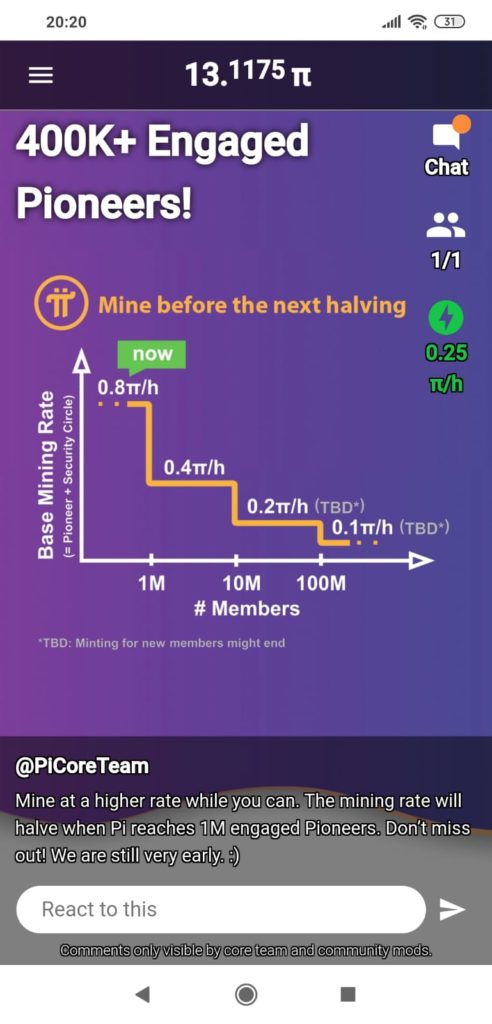Pi Network Scam Review. Is Pi Network (minepi.com) legit? Is Pi Network a Scam?
This is a scam review of Pi Network (minepi.com), a social cryptocurrency mobile mining App with proof of authenticity and what it really does. Below is how it looks on the official Pi Network website. Is this just another Cryptocurrency Scam that rip your hard earned money out of you? The Chinese characters certainly raise some brows for it’s authenticity as this whole thing claimed to be started by Stanford graduates. A pleasant surprise is on it’s way. Let’s dig further…
Activities pertaining to any transaction of Pi is currently unauthorised. Do not engage in any offer provided by 3rd party or you may suffer financial lost.
me trying to translate the chinese characters displayed on the official website
And so it seems that the chinese characters are present to warn people from getting scammed by third parties. Not much can be concluded yet. We are only at the beginning to uncovering the truth about Pi Network. To help everyone get a full picture, this Pi Network scam review of minepi.com is structured as follow:
- What is Pi Network (minepi.com)
- What does this Pi Network work
- Who are the people behind Pi Network
- What does the Pi Network App do
- Conclusion of Pi Network Scam Review
- Is the Pi Network suitable for me?
What is Pi Network? – Pi Network Scam Review
Pi Network is a network of users mining Pi, a social Cryptocurrency in it’s beta phrase. Pi Network users or members “mine” Pi using a mobile App called the Pi Network App. This Pi Network App is available to download on Apple App and Google Play Store. An APK file for Android devices without Google support is also available for download.
Cryptocurrencies are digital money. One example of cryptocurrencies is Bitcoin. Bitcoins are accepted by Microsoft as payment for software subscriptions. Cryptocurrencies are also tradeable on exchange (like Binance & Coinbase) for other cryptocurrencies. It can also be converted to fiat currencies. SGD, USD, RMB and MYR are some examples of fiat currencies (Government-backed money/ Legal tender).
me trying to explain what cryptocurries are in my own words.
How does this Pi Network works? – Pi Network Scam Review
Pi Network refers to the network in which the value of Pi can and may be determined by the level of activities and engagement. Users who have downloaded the App may also be referred to as a member of the network.
The purpose of this network is to give value to this cryptocurrency by distributing Pi. The network is structured in such a way that users who have more invites gets a higher mining rate. This is to reward users for their contribution and commitment to the network. However, it is not compulsory for users to invite others to mine the cryptocurrency. Casual members who have no intention of inviting others to the network mine at a base rate. There are no other disadvantages or whatsoever besides having a base mining rate for casual users.
Halving is a mathematical concept in cryptocurrency to safeguard its value by means of scarcity. In any currencies be it fiat or digital, the true value is determined by the level of engagement and scarcity. Halving of mining rate occurs whenever the total number of users reaches a certain milestone.
Who are the people behind Pi Network?
We have briefly touched about Pi Network. In this section of this Pi Network Scam Review, I refer the Pi Network as a term to describe Pi. Now, we are talking about the product, which is Pi. The cryptocurrency in question.
Pi was co-developed by Vincent McPhillip, MBA and Ph.D Stanford graduates Dr. Nicolas Kokkalis and Dr. Chengdiao Fan. The pictures below taken from minepi.com
The profiles of members of the core team is verifiable one way or another. Dr. Nicolas’s profile is publicly available at https://hci.stanford.edu/nicolas
It’s a match. The developers are who they claim they are. So far so good 🙂
What does the Pi Network App do?
The Pi Network App can be downloaded when you visit the Official Website of Pi Network. Once downloaded and installed, the Pi Network App requires you to fill in some details to create an account. You’ll see a message that says an invitation code is required. Remember we talked about the Pi Network? One will have to join a network to be in a network. Ok, sounds legit… The invitation code is case sensitive. Use mine if you ever need one:
JoshuaHoGwokHin

Pi Network Scam Review 01 
Pi Network Scam Review 02
The image with the nice purple background is how it looks like after successful sign-up. The counter at the top displaying 13.1175 π is how much you earned or “mined” based on the level of your commitment. The lightning button on the right with a 0.25 π/h is the rate you are getting.
You will immediately notice that the numbers on the counter increases every second. Yes, you guess it right. The moment you start the mining by activating the lightning button, your Pi starts growing little by little every second.
Throughout the entire process of downloading, installation, account creation and actual usage, you will not be asked to enter any financial information. No credit-card details, no Paypal account, no iBanking username & password. The only thing that you have been asked to enter are details required by any website for account creation. Sounds good so far! 😉
Conclusion of Pi Network Scam review
Here comes to the conclusion of this article Pi Network Scam Review. First, i’d like to thank you for your precious time and i really do hope I’ve help clear some of your doubts. In my opinion, Pi Network is not a scam and far from it. The developers are who they claim they are, the App does what it says it does, the idea of how it might work coincides with mathematical and currency concepts. On top of that, Pi Network App seems harmless to me. 😄
Is the Pi Network suitable for me? – Pi Network Scam Review
Is Pi for You? Now is the distribution phrase of the Pi Network and any interested parties are free to join. Pi Network is free and in a sense it’s as good as free money. There is no free lunch of-course. Pi Network App requires users to “re-activate” mining after every mining session. Each mining session is 24 hrs. This system ensure a certain level of commitment to the network (just a few seconds to open the app and tap the button to be exact). If you are a believer of block-chain technology or simply just interested in the potential value of Pi, earning some Pi just seems like a logical step to take.
This Pi Network Scam Review is dedicated to individuals like you and I. We should always be vigilant and do our due diligence before engaging into what seems like too good to be true offers.
Click on the download button to get started. The button is encoded with my invitation code. The invitation code you use also affect the rate of your mining. I will not delved into it as it’s beyond the scope of this article. At least you can be very sure I’m committed enough to put off this article for you.
Invitation code (case sensitive):
JoshuaHoGwokHin
🙂












